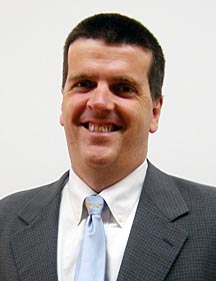Breakthrough Solutions for One of Earth's Biggest Challenges
A conversation with Richard Fuller, president of Great Forest Inc. and the Blacksmith Institute. By Alice Bumgarner
Even as Richard Fuller was running Great Forest Inc., one of the top sustainability consulting companies in the U.S., he wondered what sort of tangible environmental impact his work made. Was it reducing the amount of deforestation? Was it aiding biodiversity? Was it reducing the level of pollution that causes health problems?
As he looked for measurements, he realized that there was a gap between his sustainability endeavors and meaningful environmental change. "That was really disturbing," he says.
The example he gives is this: For a Fortune 500 client, he might help them achieve efficient lighting and reduce their energy use by 5 percent or 6 percent. But during that same time, the company might grow by 20 percent.
So, in 1999, he started Blacksmith Institute to make a difference in the world, in a way that was measurable. Today Blacksmith is doing 40 projects in 17 countries, cleaning up the world's worst polluted places. Pollution, he believes, is among the most serious problems facing our planet.
Alice Bumgarner (AB): What are some of the exciting innovations you've been involved in developing?
 Richard Fuller: I'm proud that we at Great Forest are reducing companies' carbon footprints. That's a good thing. But more importantly, those companies are trying to think more deeply about issues of real concern – climate change, pollution and biodiversity. I worry that sometimes people are more concerned about drinking bottled water than about those three big things.
Richard Fuller: I'm proud that we at Great Forest are reducing companies' carbon footprints. That's a good thing. But more importantly, those companies are trying to think more deeply about issues of real concern – climate change, pollution and biodiversity. I worry that sometimes people are more concerned about drinking bottled water than about those three big things. Meanwhile, what we're doing at Blacksmith Institute is first putting the world's pollution problems into groups – small, medium or large. A large-scale project is one where the total cost for cleaning up a problem is in the tens of millions of dollars. It'll have active polluters that need to be controlled and managed; it will require residual clean-up and social work. These are complex projects.
We become the project manager to bring in large-scale donations, from the World Bank or equivalent. We pull in key members from the government, and we drive the whole thing. For example, one project we're working on now is a reservation in northern Manila. It's massively contaminated from so many things – tanneries, fireworks manufacturers, gold refiners, lead from a battery facility – but we've designed a way to clean it up and make it inhabitable again.
AB: What is the role of innovation at Blacksmith Institute?
Richard Fuller: For us, some of the key innovations have come about in finding cost-effective, simple ways to better handle the global problems we deal with. For example, we've developed with Johns Hopkins a form to help us evaluate a site in four or five hours. Six pieces of information go into a website, which gives us a ranking of one to six. That gives us a quick look at how toxic pollutants are, so we can decide whether we want to get involved.
AB: What is the most difficult problem you and/or your team have solved?
Richard Fuller: The most difficult problems are always entrenched politics. In one country, we had to live through three different Ministers for the Environment before we finally got the third one to agree to sign off on what was obvious from the beginning.
AB: When teams are working on a problem, and they hit a barrier, what do you recommend?
Richard Fuller: Lots of patience. Often the solution is to sit down and talk, or to go on retreat for a couple of days. There's usually a lot of yelling for the first couple of meetings, but we just keep bringing it back again and again to, "How do we fix it?"
AB: What, if any, problem solving, creativity tools or innovation software do you use or are you familiar with?
Richard Fuller: We make use of the Internet and iChat. Both are extremely valuable. We have 20 people in the field in different countries. They have access to a lot of information and data on our servers, and they need that online process to work across time zones.
AB: Are you familiar with virtual collaborative innovation communities and networks (such as IdeaConnection.com) that bring together experts, facilitators, and product developers for confidential collaborative creation? What has been your experience with this type of collaboration?
Richard Fuller: No, I'm not.
AB: What blogs or other media on the topic of innovation do you read? Are there any books on innovation that you recommend to others?
Richard Fuller: I read a lot of science journals and also a lot of philosophy. It's always nice to put yourself into a spot of contemplation.
